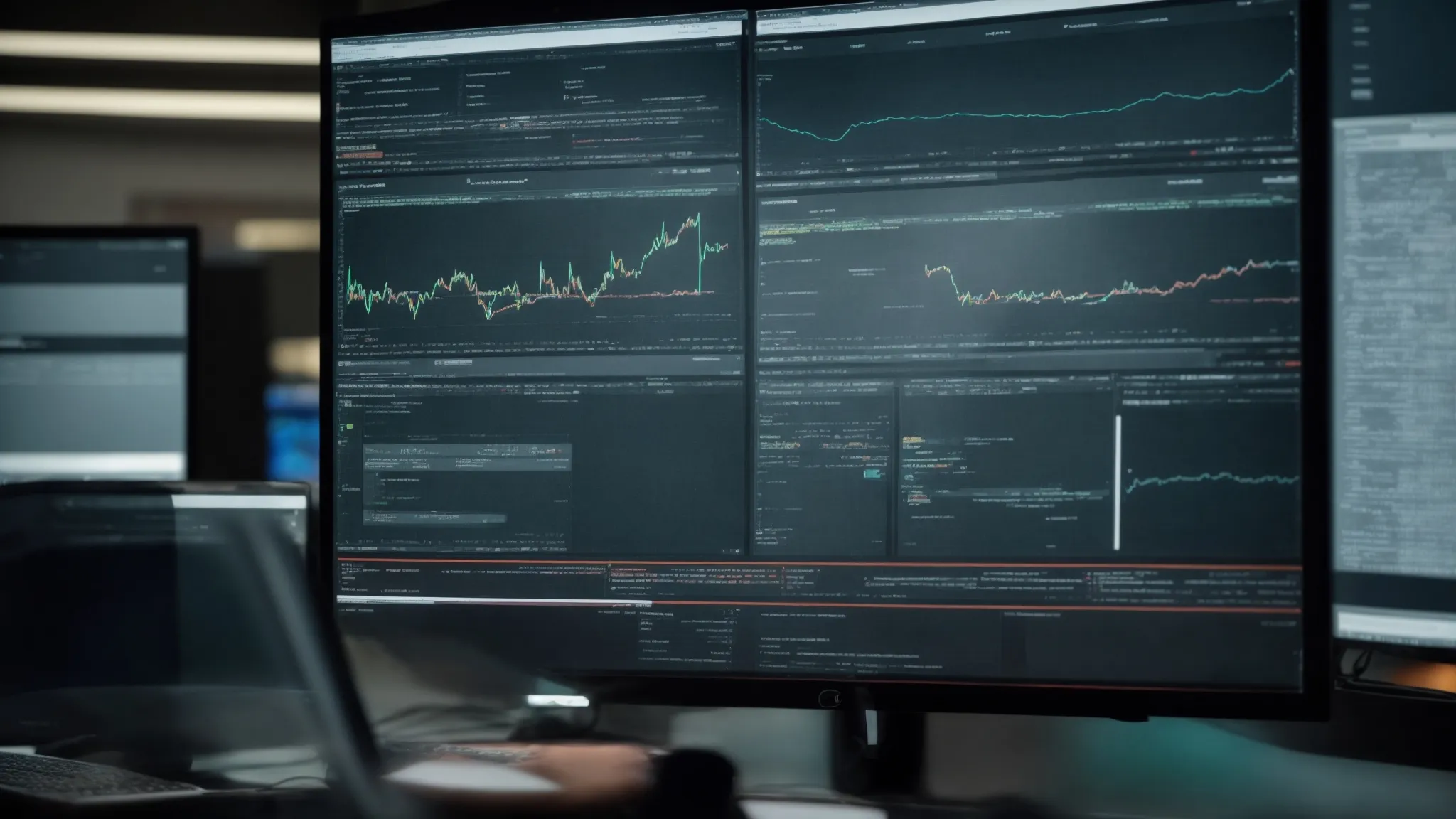Unleash Your Website’s Potential with Advanced Onsite SEO
Mastering Advanced Onsite SEO Techniques for Peak Website Performance Mastering advanced onsite SEO techniques is imperative for any web page that aspires to climb the Search Engine […]
Mastering Advanced Onsite SEO Techniques for Peak Website Performance
Mastering advanced onsite SEO techniques is imperative for any web page that aspires to climb the Search Engine Results Pages (SERPs).
Crafting a website that not only draws visitors but also converts them into customers hinges on the seamless integration of technical optimization, strategic content, and a supreme user experience.
At the forefront of optimizing these crucial elements is a concerted effort to understand and implement the latest SEO best practices.
LinkGraph‘s SEO services empower website owners to navigate the complexities of onsite SEO with precision and acumen, resulting in a significant uplift in search engine ranking and website performance.
Keep reading to uncover the transformative SEO tactics that hold the key to unlocking your site’s potential.
Key Takeaways
- LinkGraph Utilizes Advanced SEO Techniques and Search Atlas Tools to Improve Website Performance and Search Engine Ranking
- Strategic Structured Data Implementation and Content Organization Enhances Communication With Search Engines and User Relevance
- Website Optimization From LinkGraph Includes a Focus on HTTPS Security, Mobile Responsiveness, and Core Web Vitals for User Trust and Experience
- Multimedia Elements Are Optimized by LinkGraph to Balance User Engagement With Page Speed and Search Engine Visibility
- Ongoing SEO Audits, Content Refreshment, and a/B Testing Contribute to LinkGraph’s Continual Website Performance Improvement and User Conversion Optimization
Elevating Onsite SEO With Technical Optimization

As digital landscapes evolve, the caliber of on-page SEO has become a deciding factor for search engine rankings and user satisfaction.
Companies like LinkGraph, armed with their SEO services and Search Atlas SEO tool, pave the pathway for websites to leverage advanced onsite SEO techniques and drive remarkable performance.
This evolution encompasses a robust website architecture, where the structural integrity directly influences SEO success.
Compressing load times isn’t just a courtesy—it answers the call of both search algorithms and users’ expectations for efficiency.
Additionally, clarity and precision in communication with search engines go hand in hand with the strategic use of structured data.
Beyond functionality, a secure website fortified with HTTPS is paramount in establishing user trust and authority.
Together, these elements form a technical optimization blueprint that signals to both search engines and visitors the exemplar standards upheld by a website.
Mastering Website Architecture for SEO Success
LinkGraph’s focus on website architecture aims to strike a delicate balance between aesthetic allure and functional prowess. The meticulous arrangement of site elements and easy navigation positions a site not only for enhanced engagement but also for optimal indexation by search engines.
The strategic layering of informational hierarchy within a website, backed by Search Atlas SEO tools, primes a web page for peak performance. By doing so, clients experience an uptick in search engine ranking, affirming the site’s relevance and authority to the target audience.
Increasing Site Speed to Satisfy Algorithm and Users
Accelerating page speed stands as a critical objective for Search Atlas; it’s a strategic component that both search engine algorithms and users demand. As page speed directly correlates with a user’s experience and a site’s bounce rate, LinkGraph’s comprehensive suite of optimization tools meticulously tunes every element to enhance load times.
Consequently, a fast-loading site engenders favorable SERP positioning, encouraging higher visitor engagement and a positive shift in conversion metrics. Recognizing these SEO benefits, LinkGraph consistently sharpens its focus on streamlining website performance to surpass the benchmarks set by search engines and user expectations.
| SEO Factor | Impact | LinkGraph Optimization |
|---|---|---|
| Page Speed | Direct correlation with user experience and lower bounce rates | Optimization of site elements to enhance load times |
| SERP Positioning | Improved positioning leading to increased engagement | Strategies to boost site speed and meet search engine benchmarks |
| Conversion Metrics | Positive shift with higher page speed | Continuous performance streamlining to improve conversion rates |
Implementing Advanced Structured Data for Clarity
In the quest for pristine clarity and precision in communication with search engines, advanced structured data assumes a role of pivotal importance. LinkGraph champions the incorporation of meticulously crafted metadata, which acts as a beacon to search engines, signaling the nuanced context and content of a web page.
Search Atlas tools play an integral part in this strategic implementation, structuring data in a way that not only defines but also distinguishes a website’s offerings. Organizing and labeling content effectively results in an unambiguous presentation to search engines, which aids in better indexing of web pages and serves up more relevant search results to potential visitors:
| SEO Best Practice | Role | LinkGraph’s Implementation |
|---|---|---|
| Structured Data | Facilitates clearer communication with search engines | Expert crafting and implementation of metadata |
| Content Labeling | Aids in accurate indexing and relevance | Strategic organization using Search Atlas tools |
| Search Relevance | Ensures delivery of pertinent search results | Enhanced presentation of content to search engines |
Securing Your Website With HTTPS for Trust
In an era where data breaches are not anomalies but expectations, establishing trust with website visitors has never been more crucial. LinkGraph recognizes the significance of this trust and elevates website security by ensuring encryption through HTTPS. This commitment not only shields data exchange between a site and its users but also endorses confidence in the brand.
Google itself has underscored the importance of HTTPS as a ranking signal, a detail that expertly aligns with LinkGraph’s dedication to comprehensive SEO strategies. The adoption of HTTPS transcends basic security; it fortifies a site’s credibility both in the perceptual realm of the visitor and the algorithmic eyes of search engines, ultimately benefitting the site’s search engine positioning and user retention.
Strategic Keyword Optimization in Content

To truly excel in the complex terrain of onsite SEO, mastery over the intricacies of keyword optimization is not just an asset—it’s a necessity.
LinkGraph’s strategic approach embraces the nuanced fabric of semantic search principles, ensuring that content produced resonates with both the searcher’s intent and the contextual probing of algorithms.
Their focus shifts towards creating content clusters that establish a site as an irrefutable authority on specific topics, thereby elevating the brand’s resonance with its target audience.
Simultaneously, honing in on the intent behind user queries yields content that captivates and engages, fostering a deeper connection between visitor and site.
These practices form the cornerstone of a Content Strategy that is both SEO-enabled and user-centric, propelling website performance to unprecedented heights.
Delving Into Semantic Search Principles
LinkGraph’s foray into semantic search optimization reflects a strategic comprehension of search engine algorithms and user intent. By penetrating the essence of search queries, LinkGraph’s content strategy aligns with the nuanced relationships between terms, ensuring that a user’s query and the context it conveys are met with relevant and authoritative content.
This approach underpins the development of a cohesive content ecosystem: content that clearly addresses the underlying queries and topics that users are seeking information on becomes the bedrock of a brand’s digital presence, thus amplifying its visibility and authority in the eyes of both users and search engines:
- Analyzing the semantic core of user queries to guide content development.
- Structuring content to echo the searcher’s journey from query to solution.
- Employing Search Atlas to refine content, ensuring congruence with the target keyword spectrum.
LinkGraph not only captures a snapshot of current search trends but anticipates emerging queries, adapting content to maintain relevance. Such dynamism positions a website to dominate its niche, bridging the gap between the wealth of information offered and the specific needs of its audience.
Crafting Content Clusters for Topic Authority
Exclusive to LinkGraph’s strategic methodology is the assembly of content clusters, which steer clear of obsolete keyword stuffing and embrace integral SEO best practices. Constructing these clusters allows a website to establish itself as a leading beacon within its specific topical sphere, hence influencing its perceived topical authority, which is pivotal for both search engines and the enrichment of user experience.
Employing Search Atlas as its compass, LinkGraph architects these clusters with a level of precision that enables individual web pages to collectively support a common theme, bolstering the website’s subject matter expertise. This interlinked structure not only heightens the relevance of the site’s content but also elevates its search engine ranking, making it more discoverable to a keenly targeted audience.
Focusing on User Intent for Better Engagement
LinkGraph orchestrates its SEO approach by placing a premium on the understanding of user intent, tailoring content to the expectations and needs of the website visitor. By discerning the motivations that drive the searcher’s behavior, the content crafted not only addresses their inquiries but also captivates, ensuring a richer, more engaging user experience.
Through the meticulous analysis of search intent, LinkGraph’s SEO strategies secure a competitive advantage, ensuring that each web page not only resonates with the audience but also incites interaction. This targeted focus on user intent paves the way for enhanced engagement, fostering a profound connection that aids in propelling website performance and, ultimately, conversion rates.
Harnessing the Power of HTML Tags

Commanding attention from search engines and sculpting an intuitive user experience hinges on the elegant manipulation of HTML tags—a fine art in the realm of onsite Search Engine Optimization.
LinkGraph’s mastery in this area is exemplified through the strategic optimization of meta tags, ensuring that visibility is not left to chance.
The organization of content gains remarkable structure with the judicious use of header tags, carving out a clear user path and delineating content priorities.
Furthermore, the integration of descriptive alt text within images is not merely about accessibility—it is a calculated move to inject an SEO advantage into every visual element.
Together, these techniques form a trinity of HTML enhancements that work cohesively to sharpen a website’s competitive edge and soar its online stature.
Leveraging Meta Tags for Improved Visibility
In the realm of advanced onsite SEO, LinkGraph recognizes that visibility in the digital space is paramount. The proper use of meta tags, including title tags and meta descriptions, becomes a crucial focus. Crafting meta tags with precision, LinkGraph ensures that every web page broadcasts a clear and enticing message to search engines, enhancing the click-through rate from SERPs.
Adeptly optimizing meta tags requires a surgical approach to align with search intent and to encapsulate the essence of the page content. LinkGraph excels in formulating title tags that captivate and meta descriptions that succinctly preview the page, paving the way for improved visibility and drawing a more targeted audience to the site.
Utilizing Header Tags for Structured Content Hierarchy
Deliberate organization of content via the judicious use of header tags is an arena where LinkGraph demonstrates its prowess. Understanding that a well-structured content hierarchy enhances readability and facilitates seamless navigation, LinkGraph meticulously employs H1 to H6 tags to define sections and sub-sections, guiding users and search engines through a coherent and information-rich journey.
In this context, LinkGraph’s approach to onsite SEO embraces header tags to delineate a clear content hierarchy, delivering an implicit guide for website visitors. This technique not only simplifies the user’s path to information but also reinforces the thematic structure of the content, thereby aiding search engines in contextualizing and ranking the web page more effectively.
Embedding Alt Text in Images for SEO Boost
Incorporating alt text for images presents a dual benefit; it bolsters accessibility while simultaneously enhancing a website’s SEO footprint. LinkGraph capitalizes on this by embedding descriptive and keyword-rich alt text, ensuring that each image contributes to the page’s relevancy in search engine algorithms and improves overall visibility within Google search results.
By effectively using alt text, LinkGraph ensures that even non-displayed images don’t miss an opportunity to enrich a site’s SEO value. This approach exemplifies a strategic SEO technique where every element on a page, visual or otherwise, is optimized for maximum impact on search engine rankings, leading to an all-encompassing enhancement of the site’s SEO profile.
Advanced User Experience (UX) Techniques for SEO

In today’s digital environment, exceptional onsite search engine optimization is inextricably linked to delivering a sterling user experience.
The continuous progression of mobile usage has not only informed Google’s mobile-first indexing but underscored the necessity of responsive design for peak website performance.
LinkGraph, cognizant of these evolving standards, places a considerable premium on user experience by adopting mobile-first strategies, meticulously refining a site’s adherence to Core Web Vitals, and constructing intuitive navigation systems.
Through these advanced techniques, LinkGraph ensures that website performance is attuned to the needs of users and the requirements of search engines, thus solidifying a website’s foothold at the pinnacle of search rankings.
Prioritizing Mobile-First Design for Mobile Indexing
LinkGraph keenly recognizes the advent of mobile-first design as indispensable to SEO, particularly with search engines now defaulting to mobile-first indexing. By prioritizing mobile responsiveness, LinkGraph ensures that sites not only cater to the vast mobile user base but also adhere to the search engines’ protocols, amplifying online visibility and user engagement.
Embracing the paradigm shift towards mobile usage, LinkGraph tailors websites to function seamlessly across all devices, ensuring that the architecture and content deliver a flawless user experience. This approach ensures that website performance remains robust, both in garnering positive user interactions and in satisfying the rigorous criteria set forth by search engines for mobile indexing.
Optimizing for Core Web Vitals for Superior UX
LinkGraph’s commitment to stellar user experience is exemplified through the meticulous optimization of Core Web Vitals, integral components that Google utilizes as ranking factors. The company’s expert strategies ensure that loading times, interactivity, and visual stability meet the benchmarks for excellence, profoundly enhancing site usability and user satisfaction.
Cognizant of the significant influence these metrics hold over user experience and search engine evaluation, LinkGraph’s optimization practices aim to elevate a website’s performance in line with these critical UX pillars. As a result, websites optimized by LinkGraph not only shine in the eyes of visitors but also climb the ranks in search engine results, capturing the essence of successful SEO integration.
Crafting an Intuitive Navigation System
In the realm of on-page search engine optimization, LinkGraph understands that crafting an intuitive navigation system is critical for user retention and website authority. By facilitating a seamless user journey through logical and straightforward navigation, LinkGraph ensures that visitors can find the information they seek with minimal friction, enhancing the overall user experience and aiding in search engine crawling and indexation.
| Navigation Element | User Experience Impact | LinkGraph’s Optimization Focus |
|---|---|---|
| Logical Structure | Facilitates ease of information retrieval | Simplified, user-centric navigation paths |
| Consistency | Reduces user confusion and bounce rate | Uniform navigation elements across pages |
| Search Engine Indexation | Enhances visibility and ranking potential | Clear hierarchy and crawlable link structures |
LinkGraph diligently refines navigation elements, ensuring consistency throughout the site: menus, sidebars, and footers maintain a uniform interface, simplifying the learning curve for new visitors. This meticulous approach to navigation design serves a dual purpose: it bolsters the likelihood of visitors engaging with the content and ensures that search engine bots can effortlessly traverse the site, improving the website’s visibility and indexability.
Leveraging Multimedia for Onsite Optimization

Embracing the full spectrum of onsite search engine optimization involves a keen understanding of the role multimedia plays in modern web design.
LinkGraph asserts that there is an art to striking an optimal balance between text and visuals to enrich the user’s experience without compromising on page speed.
With a focus on streamlining multimedia elements for expedited load times and optimizing these assets for search engines, LinkGraph not only enhances the aesthetic appeal of a site but ensures it serves the underlying SEO objectives.
Their expertise becomes evident as they harmonize images and videos within the onsite content framework, making multimedia a powerful ally in the quest for peak website performance.
Balancing Text and Visuals for Varied Content
In the pursuit of superior website performance, LinkGraph deftly balances the visual allure of multimedia with the informative power of textual content. Their strategy ensures that each serves to complement, not overshadow, providing a rich tapestry that captivates the visitor while maintaining SEO integrity.
By embedding optimally sized images and streamlined videos alongside compelling copy, LinkGraph crafts an engaging narrative across the site’s pages. This equilibrium between text and visuals not only enhances the user experience but also keeps the site agile and responsive to maintain vital page speed metrics.
Compressing Images and Videos for Faster Load Times
Within the intricate matrix of onsite Search Engine Optimization, LinkGraph situates multimedia compression as a cornerstone of site performance. Recognizing the intricate balance between visual quality and loading efficiency, the company implements advanced compression algorithms to expedite page display times without sacrificing the depth and vibrancy of visual content.
Such optimization techniques manifest as a strategic priority for LinkGraph, ensuring a user’s swift access to rich multimedia without undue delay:
- Streamlining visual elements to minimize data payload.
- Implementing responsive images that adapt to various screen sizes.
- Utilizing modern video formats that offer high compression efficiency.
This meticulous attention to detail results in a more seamless user experience and contributes positively to the website’s search engine ranking, reaffirming the site’s commitment to superior performance and technical finesse.
Integrating Multimedia With SEO in Mind
LinkGraph integrates multimedia with a deep understanding of SEO imperatives, ensuring that images, videos, and audio are not just interactive elements but pivotal parts of an SEO strategy. Every piece of multimedia is mapped out and optimized to have a purpose within the site’s SEO narrative and content strategy, contributing to higher search rankings and user engagement.
- Optimizing multimedia for faster page load times without compromising quality.
- Ensuring multimedia elements are indexed with SEO-enriched alt text and file names.
- Incorporating multimedia in a way that supports text content and keyword optimization.
This meticulous integration goes beyond the surface, as LinkGraph embeds proper schema markup for multimedia content, enabling search engines to understand and display these elements within rich snippets. The application of structured data to multimedia items ensures that visual assets become powerful cogs in the machinery of onsite SEO, fully aligned with the website’s overarching SEO objectives.
Continuous Onsite SEO Audits and Adjustments

As the digital realm matures, vigilance in monitoring and refining website performance through onboard SEO audits and adjustments becomes paramount.
Seasoned with expertise, LinkGraph deploys advanced analytics to glean insights and spearhead a continual evolution of a website’s SEO landscape.
This analytical prowess enables LinkGraph to drive a site into the limelight by consistently refreshing content, ensuring relevancy in an ever-changing market.
Furthermore, the strategic employment of A/B testing on page elements evolves the site’s conversion potential, standing as testimony to the relentless pursuit of optimization for superior user engagement and conversion rates.
Employing Advanced Analytics for Performance Insights
In the realm of onsite SEO, LinkGraph adeptly utilizes advanced analytics to carve out a strategic advantage, propelling websites towards peak performance. These analytics tools present invaluable insights into visitor behavior, search engine ranking factors, and the overall health of a site, crystallizing data into actionable intelligence.
LinkGraph’s analytical acumen translates into identifying opportunities for growth and swiftly addressing areas in need of optimization. Armed with comprehensive reporting and deep data insights, the brand fosters informed decisions that consistently optimize website effectiveness and user engagement:
- Dissecting analytics to pinpoint user experience improvements.
- Aligning website adjustments with data-driven SEO strategies.
- Adapting content to evolving trends based on analytics findings.
Regularly Updating Content to Remain Relevant
In the fast-paced world of SEO, content stagnation is not an option for sites aspiring to maintain and enhance their search engine standing. LinkGraph champions the idea that regularly updated content is key, ensuring that a website remains a relevant resource for users and search engines.:
- Spearheading content revisions to align with current industry trends and user interests.
- Refreshing outdated articles to reflect the latest research and industry developments.
- Injecting new keyword opportunities into existing content to capitalize on emerging search trends.
LinkGraph excels at keeping a site’s content fresh and engaging, a strategy that serves to fortify ranking positions and encourage recurrent visits. By monitoring shifts in user queries and market dynamics, content updates are systematically executed, solidifying a site’s status as a thought leader in its niche.
A/B Testing Page Elements for Conversion Optimization
LinkGraph harnesses the compelling power of A/B testing to enhance onsite SEO, refining page elements with a keen focus on maximizing conversion optimization. This precision-driven technique systematically evaluates varying versions of a webpage against each other to establish which iteration yields superior user engagement and conversion rates. Thus, LinkGraph’s commitment to SEO is demonstrated not only in increasing traffic but also in optimizing each visit towards a valuable conversion.
By strategically modifying and measuring the impact of distinct page features such as calls to action, headline phrasing, or image placements, LinkGraph pinpoints the variables that most significantly motivate visitors toward desired actions. This tailored approach enables clients to achieve a refined user experience that is underpinned by data and geared towards an elevated conversion rate, solidifying the optimization process as both an art and a science in the quest for search engine prominence and website success.
Frequently Asked Questions
How can technical optimization improve onsite SEO performance?
Technical optimization enhances onsite SEO performance by streamlining a site’s infrastructure to improve search engine crawling and user experience, thereby increasing the likelihood of higher search engine rankings and user engagement. Through methods such as optimizing page speed, mobile responsiveness, and improving internal linking structures, businesses can ensure that their website meets SEO best practices, which is integral to achieving visibility in search engine results.
What strategies can be used for keyword optimization in website content?
To optimize website content effectively for keywords, it’s imperative to engage in comprehensive keyword research, identifying terms closely aligned with the user’s search intent and the business’s target audience. Once the key phrases are pinpointed, they should be judiciously integrated into the website’s title tags, meta descriptions, page content, and anchor text, respecting the natural flow of the language to ensure a seamless user experience that benefits both the website visitor and the search engine ranking.
How can HTML tags be leveraged to enhance onsite SEO?
HTML tags are instrumental in boosting onsite SEO by directly communicating with search engines about the structure and content of a webpage, which aids in indexation and user comprehension. Strategic use of these tags – such as title tags, meta descriptions, header tags, alt text for images, and proper schema markup – can significantly enhance the visibility of a website in search results by reinforcing keyword relevance and improving the overall user experience.
What are some advanced user experience (UX) techniques that can boost SEO?
Advanced User Experience (UX) techniques that elevate Search Engine Optimization (SEO) include the strategic implementation of multivariate testing to refine user interface elements and the optimization of page speed to minimize bounce rates. Furthermore, organizations like LinkGraph emphasize the importance of an SEO Audit, which often evaluates UX factors that influentially impact search engine rankings and visitor satisfaction.
How can multimedia elements be effectively utilized for onsite optimization?
Multimedia elements enhance user experience and engagement by breaking up text and illustrating points visually, which can lead to increased dwell time and lower bounce rates. Effectively integrating multimedia such as images, videos, and infographics also aids in communicating the page content’s relevance to search engines, contributing to improved search engine rankings.
Conclusion
Mastering advanced onsite SEO techniques is essential for achieving peak website performance. By optimizing website architecture, accelerating page speed, employing structured data, and securing sites with HTTPS, companies like LinkGraph ensure that websites not only meet search engine benchmarks but also exceed user expectations.
With tools like Search Atlas, they craft content that resonates with both algorithms and user intent, further elevating search rankings and engagement through strategic keyword optimization and content clusters. The use of HTML tags and multimedia is optimized for visibility and speed, enhancing the user experience without compromising performance.
In addition to these technical aspects, backlinks play a crucial role in a comprehensive website optimization strategy. By strategically building links and monitoring competitors, businesses can gain a competitive edge in the online landscape. Content marketing, including blog posts and engaging multimedia, serves as a powerful tool for attracting organic traffic and enhancing the overall user experience.
LinkGraph’s continuous onsite SEO audits and adjustments, informed by advanced analytics and A/B testing, keep websites relevant and competitive. Incorporating conversion rate optimization techniques and leveraging Local SEO strategies further solidify a website’s standing in the digital realm.
In summary, advanced onsite SEO techniques, encompassing technical SEO, content marketing, and strategic link building, are the cornerstone of a successful digital presence. They drive robust engagement, ensuring sustained conversion rates and reinforcing a website’s competitiveness in the dynamic landscape of search marketing.














































































